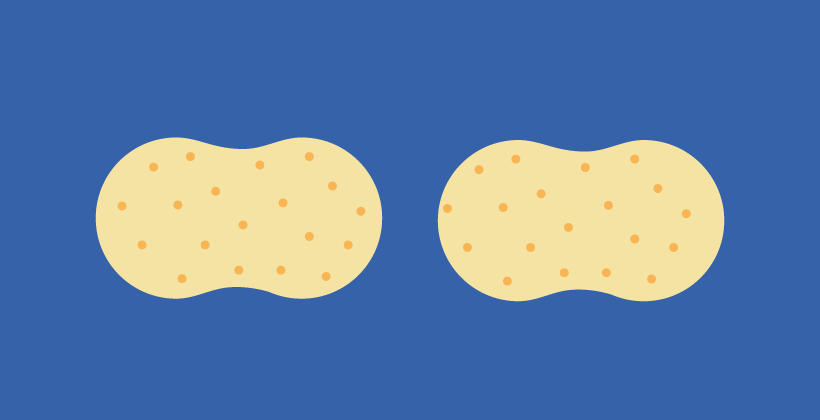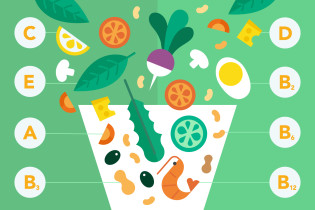Adult nutrition
Last Updated : 03 March 2006Every day we are bombarded with nutrition and health messages and a seemingly endless array of concerns about lifestyle and diet. Healthy eating and a healthful way of life are important to how we look, feel and how much we enjoy life. The right lifestyle decisions, with a routine of good food and regular exercise, can help us make the most of what life has to offer. Making smart food choices early in life and through adulthood can also help reduce the risk of certain conditions such as obesity, heart disease, hypertension, diabetes, certain cancers and osteoporosis.
1. Key factors of a healthy diet
1.1. Enjoy the wide variety of foods
This concept is the most consistent health message in dietary recommendations around the world. We need more than 40 different nutrients for good health and no single food can supply them all. That's why consumption of a wide variety of foods (including fruits, vegetables, cereals and grains, meats, fish and poultry, dairy products and fats and oils), is necessary for good health and any food can be enjoyed as part of a healthy diet. Some studies have linked dietary variety with longevity. In any event, choosing a variety of foods adds to the enjoyment of meals and snacks.
1.2. Eat regularly
Eating is one of the life's great pleasures and its important to take time to stop, relax and enjoy mealtimes and snacks. Scheduling eating times also ensures that meals are not missed, resulting in missed nutrients that are often not compensated for by subsequent meals. This is especially important for school children, adolescents and the elderly.
Breakfast is particularly important as it helps kick-start the body by supplying energy after the all-night fast. Breakfast also appears to help control weight. All mealtimes offer the opportunity for social and family interaction. So whether it is three square meals or six mini-meals or snacks, the aim is to make healthy choices you can enjoy.
1.3. Balance and moderation
Balancing your food intake means getting enough, but not too much, of each type of nutrient. If portion sizes are kept reasonable, there is no need to eliminate favourite foods. There are no "good" or "bad" foods, only good or bad diets. Any food can fit into a healthy lifestyle by remembering moderation and balance.
Moderate amounts of all foods can help ensure that energy (calories) intake is controlled and that excessive amounts of any one food or food component are not eaten. If you choose a high fat snack, choose a lower fat option at the next meal. Examples of reasonable serving sizes are 75 -100 grams (the size of a palm) of meat, one medium piece of fruit, ½ cup raw pasta or one scoop of ice cream (50g). Ready-prepared meals offer a handy means of portion control and they often have the energy (calorie) value listed on the pack.
1.4. Maintain a healthy body weight and feel good
A healthy weight varies between individuals and depends on many factors including gender, height, age and heredity.
Excess body fat results when more calories are eaten than are needed. Those extra calories can come from any source - protein, fat, carbohydrate or alcohol - but fat is the most concentrated source of calories.
Physical activity is a good way of increasing the energy (calories) expended and it can also lead to feelings of well-being. The message is simple: if you are gaining weight eat less and be more active.
1.5. Don't forget your fruits and vegetables
Many Europeans do not meet the recommendations for at least five servings of fruits and vegetables daily. Numerous studies have shown an association between the intake of these foods and a decreased risk of cardiovascular disease and certain cancers. An increased intake of fruits and vegetables has also been associated with decreased blood pressure. People can fill up on fresh fruit and vegetables because they are good sources of nutrients and the majority are naturally low in fat and calories.
Nutritionists are paying much more attention to fruits and vegetables as "packages" of nutrients and other constituents that are healthful for humans. The "antioxidant hypothesis" has drawn attention to the role of micronutrients found in fruits and vegetables like vitamins C and E , as well as a number of other natural protective substances. The carotenes (beta-carotene, lutein and lycopene), the flavonoids (phenolic compounds that are widespread in commonly consumed fruits and vegetables such as apples and onions and beverages derived from plants like tea, cocoa and red wine) and the phytoestrogens (principally isoflavones and lignans), are being demonstrated to have beneficial roles in human health.
1.6. Base the diet on foods rich in carbohydrates
Most dietary guidelines recommend a daily diet in which at least 55% of the total calories come from carbohydrates. This means making more than half of our daily food intake should consist of carbohydrate-containing foods such as grains, pulses, beans, fruits, vegetables and sugars. Choosing wholegrain bread, pasta and other cereals will help to boost fibre intake.
Although the body treats all carbohydrates in the same way regardless of their source, carbohydrates are often split into "complex" and "simple" carbohydrates. Complex carbohydrates that come from plants are called starch and fibres, and these are found for example in cereal grains, vegetables, breads, seeds, legumes and beans. These carbohydrates consist of long strands of many simple carbohydrates linked together. Simple carbohydrates (sometimes called simple sugars) are found for example in table sugar, fruits, sweets, jams, soft drinks, fruit juices, honey, jellies and syrups. Both complex and simple carbohydrates provide the same amount of energy (4 calories per gram) and both can contribute to tooth decay, especially when oral hygiene is poor.
1.7. Drink plenty of fluids
Adults need to drink at least 1.5 litres of fluid daily, even more if its hot or they are physically active. Plain water is a good source of liquid but variety can be both pleasant and healthy. Alternative sources are juices, soft drinks, tea, coffee and milk.
1.8. Fats in moderation
Fat is essential for good health. Fats provide a ready source of energy and enable the body to absorb, circulate and store the fat-soluble vitamins A, D, E and K. Fat-containing foods are needed to supply "essential fatty acids" that the body cannot make. For example, oil-rich fish and fish oil supplements are rich sources of the omega-3 polyunsaturated fatty acids (n-3 PUFAs) alpha linolenic acid (ALA), eicosapentaenoic acid (EPA) and docosahexaenoic acid (DHA). These, along with omega-6 polyunsaturated fatty acids (n-6 PUFAs) such as linoleic acid (LA) and arachidonic acid (AA), must be consumed in the diet.
Too much fat however, especially saturated fats, can lead to adverse health effects such as overweight and high cholesterol and increase the risk of heart disease and some cancers.
Limiting the amount of fat, especially saturated fat in the diet -but not cutting it out entirely- is the best advice for a healthy diet. Most dietary recommendations are that less than 30% of the day's total calories should come from fat and less than 10% of the day's total calories should come from saturated fat.
1.9. Balance the salt intake
Salt (NaCl) is made up of sodium and chloride. Sodium is a nutrient and is present naturally in many foods. Sodium and chloride are important in helping the body to maintain fluid balance and to regulate blood pressure.
For most people, any excess sodium passes straight through the body however in some people it can increase blood pressure. Reducing the amount of salt in the diet of those who are sensitive to salt may reduce the risk of high blood pressure. The relationship between salt intake and blood pressure is still unclear and individuals should consult their doctor for advice.
1.10. Start now - and make changes gradually
Making changes gradually, such as eating one more fruits/portion of vegetables each day, cutting back on portion sizes, or taking the stairs instead of the lift, means that the changes are easier to maintain.
2. Why is physical activity also important?
The advise for increased physical activity is strongly linked to overall healthy lifestyle recommendations because it affects energy balance and the risk of lifestyle-related diseases. Over the past few years, many position papers have set out the importance of moderate physical activity for good health. These reports indicate that being physically active for at least 30 minutes daily reduces the risk of developing obesity, heart disease, diabetes, hypertension and colon cancer, all of which are major contributors to morbidity and mortality in Europe. In addition, in both children and adults, physical activity is related to improvements in body flexibility, aerobic endurance, agility and coordination, strengthening of bones and muscles, lower body fat levels, blood fats, blood pressure and reduced risk of hip fractures in women. Physical activity makes you feel better physically and encourages a more positive mental outlook.
Increases in physical activity levels are needed in every age group and recommendations are that adults be physically active for at least 30 minutes on most days of the week.
3. What groups are responsible for promoting healthy lifestyles?
The responsibility for promoting healthy diets and increasing levels of physical activity must involve the active participation of many groups including governments, health professionals, the food industry, the media and consumers. There is a shared responsibility to help promote healthy diets that are low in fat, high in complex carbohydrates and that contain large amounts of fresh fruits and vegetables, along with regular amounts of physical activity
Ultimately, it is consumers who choose which foods to eat and their choices are influenced by a large number of factors such as quality, price, taste, custom, availability, and convenience. Consumer education, the development and implementation of food based dietary guidelines, nutrition labelling, nutrition education in schools and increased opportunities for physical activity can all help to improve the nutritional well-being of people.
Bibliography
- Food and Agriculture Organisation of the United Nations (1997). Getting the best from your food. Rome.
- Hu, F. B.; Rimm, E. B.; Stampfer, M.J., Ascherio, A., Spiegelman, D., Willet, W.C., (2000). Prospective study of major dietary patterns and risk of coronary heart disease in man. American Journal of Clinical Nutrition, 72:912-921.
- Johnson, R. K. (2000). The 2000 Dietary Guidelines for Americans: foundation of US nutrition policy. British Nutrition Foundation Bulletin, 25:241-248.
- Office of Population Censuses and Surveys (1994). General Household Survey. HMSO, London.
- Richardson, D. P. (2000). The science behind wholegrain and the reduced risk of heart disease and cancer. British Nutrition Foundation Bulletin, 25:353-360.
- Stamler, J.; Neaton, J. D. and Wentworth, D. N. (1989). Blood pressure (systolic and diastolic) and risk of fatal coronary heart disease. Hypertension, 13(suppl. 5):2-12.
- World Health Organisation (1989). MONICA Project: risk factors. International Journal of Epidemiology, 18(suppl. 1):S46-S55.
- World Health Organisation (1995). Epidemiology and prevention of cardiovascular diseases in elderly people. WHO Technical Report Series 853, Geneva.
- World Health Organisation (1996). Hypertension Control. WHO Technical Report Series 862, Geneva.



